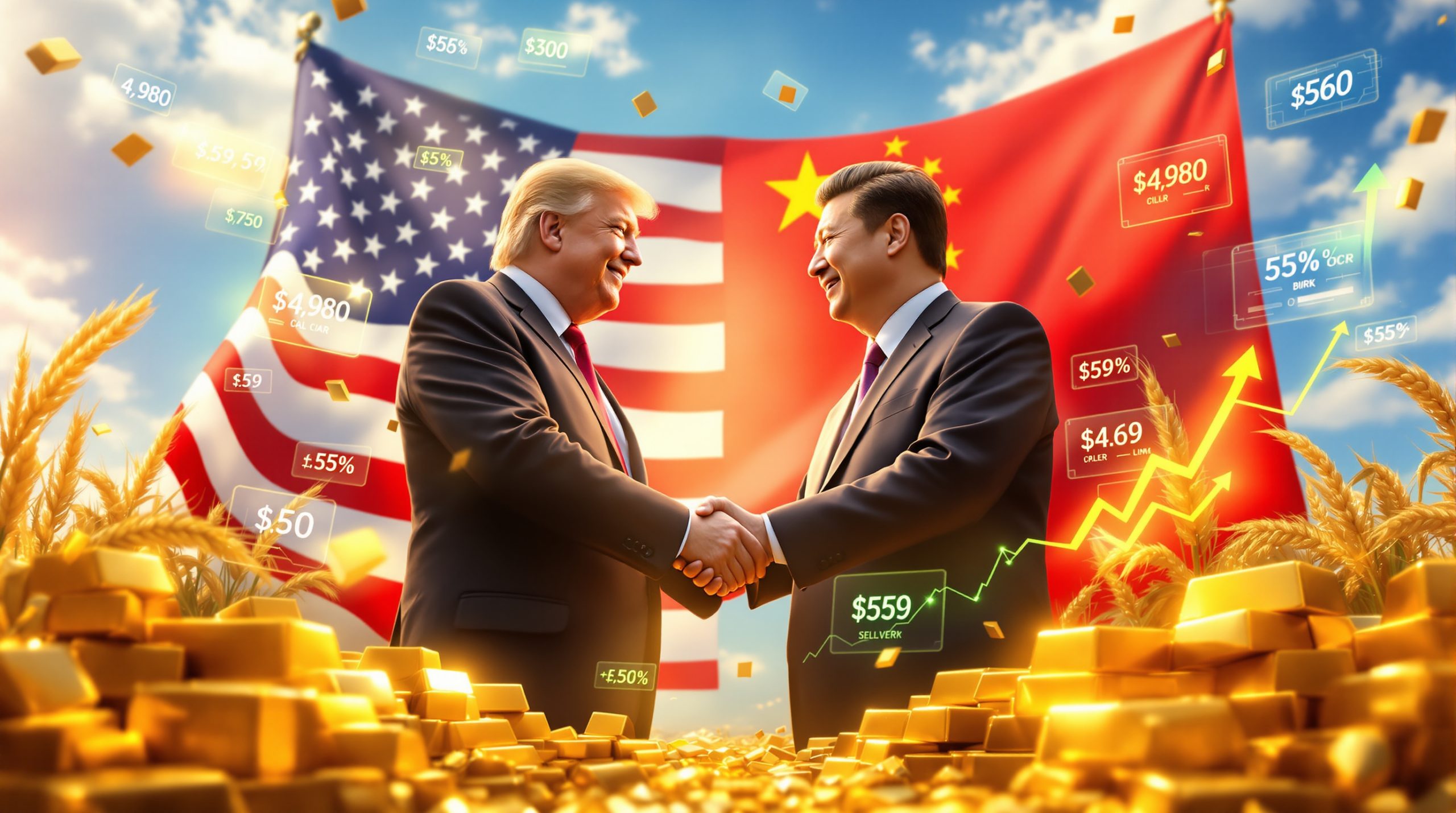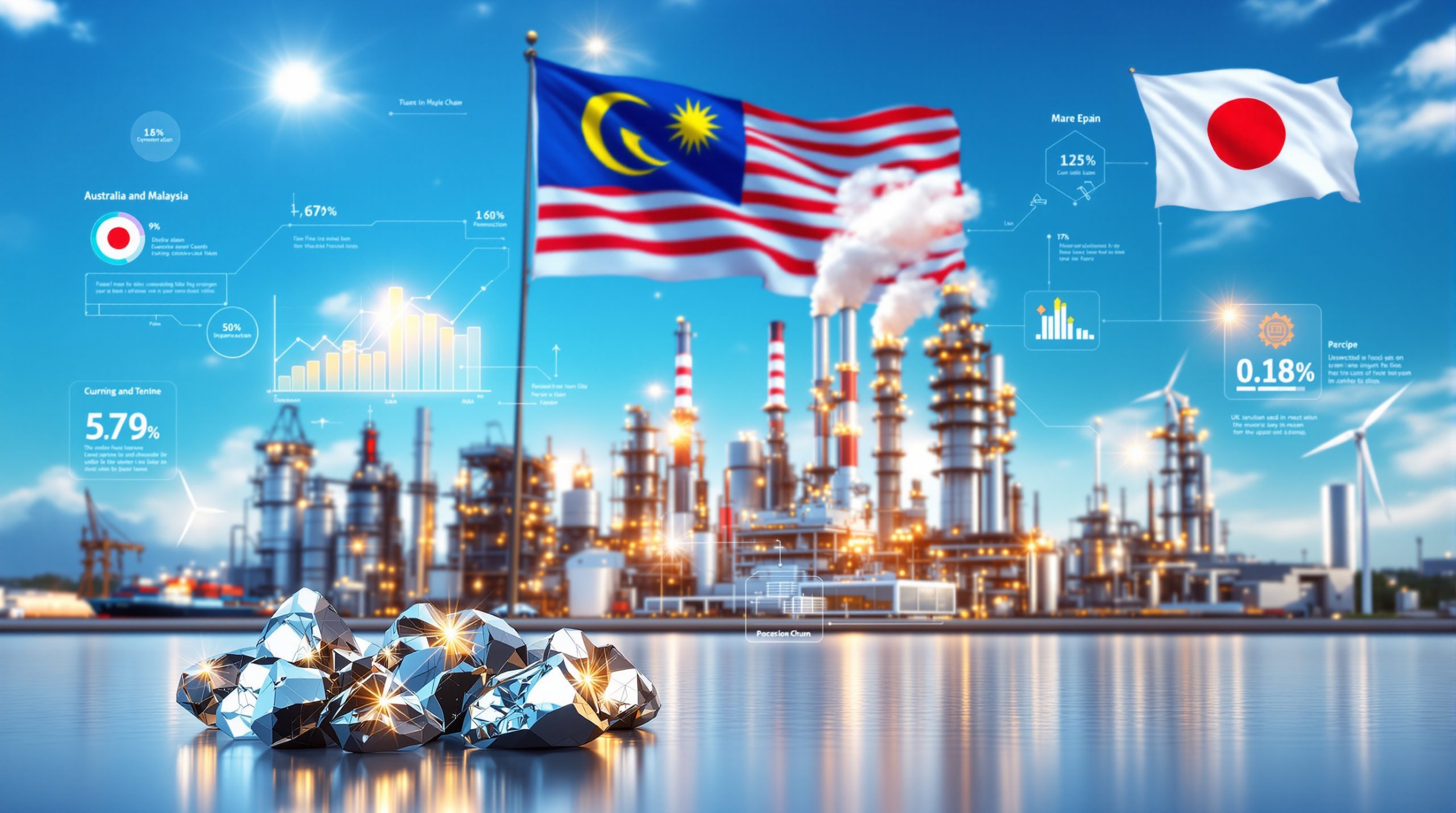Breaking Down the October 2025 Agreement
The US-Thailand rare earth pact represents a pivotal moment in global supply chain strategy, officially signed on October 26, 2025, during the ASEAN summit in Kuala Lumpur. President Donald Trump and Deputy Prime Minister Anutin Charnvirakul formalised this Memorandum of Understanding titled "Cooperation to Diversify Global Critical Minerals Supply Chains and Promote Investments," marking Thailand's entry into America's Southeast Asian critical minerals initiative.
The agreement encompasses a comprehensive range of operations across the entire rare earth value chain, including exploration, extraction, processing, refining, and recycling activities. This broad scope reflects the strategic intent to build complete supply chain alternatives rather than focusing solely on raw material extraction.
Furthermore, this partnership emerges alongside similar developments in critical minerals energy transition efforts globally, demonstrating the increasing importance of supply chain diversification. The timing coincides with Trump's critical minerals order, which has prioritised securing alternative sources for strategic materials.
Framework Structure and Legal Implications
The non-binding nature of this MOU provides Thailand with significant flexibility in implementation. Thai officials have emphasised that all future contracts and operational activities must comply with Thai national law, effectively preserving sovereignty over final investment decisions. This structure allows Thailand to participate in US-led diversification efforts without compromising its ability to maintain relationships with other trading partners.
The framework approach suggests a gradual, voluntary engagement model rather than an exclusive partnership arrangement. This positioning addresses domestic Thai concerns about foreign dependency whilst providing the United States with a cooperative partner in its supply chain resilience strategy.
Challenging China's Market Dominance Through Strategic Partnerships
Current Global Supply Chain Vulnerabilities
China's overwhelming control of rare earth markets creates systemic vulnerabilities for Western manufacturers and defence systems. According to data from the Center for Strategic and International Studies, China maintains approximately 70% of global mining operations and an estimated 90% of processing capacity. This concentration represents one of the most significant supply chain dependencies in modern industrial history.
| Metric | China's Share | Rest of World |
|---|---|---|
| Mining Operations | 70% | 30% |
| Processing Capacity | 90% | 10% |
| Downstream Manufacturing | 85% | 15% |
The processing dominance proves particularly concerning, as rare earth separation and refining require specialised technical expertise and sophisticated environmental containment systems. Even nations with significant rare earth deposits often lack the processing infrastructure to convert raw materials into usable products for electronics, defence systems, and clean energy applications.
Strategic Diversification Objectives
The US-Thailand rare earth pact addresses these vulnerabilities through geographic and operational diversification. Rather than attempting to completely replace Chinese supply chains, the strategy focuses on creating alternative processing and extraction capabilities that reduce single-nation dependency. This approach recognises that eliminating Chinese participation entirely would be neither feasible nor economically optimal.
Recent Chinese export restrictions have highlighted the urgency of this diversification effort. The US objectives centre on building resilient supply networks that can maintain critical material flows during geopolitical tensions or trade disputes. Thailand's participation, alongside similar agreements with Malaysia, creates multiple sourcing options within a strategically important region.
Consequently, the concept of a "Southeast Asian rare earth highway" emerges from coordinated regional partnerships designed to establish interconnected processing and transportation infrastructure. This network approach distributes both risks and benefits across multiple nations whilst creating redundancy in supply chain options.
Thailand's Mineral Resources and Infrastructure Assessment
Current Mining Assets and Capabilities
Thailand brings established heavy metals mining experience through its tin and tungsten operations, providing a foundation of workforce expertise and regulatory frameworks. However, the country currently lacks extensive rare earth processing capacity and does not maintain a formal critical minerals classification system comparable to other nations.
The existing tin industry demonstrates Thailand's capability in:
• Workforce Development: Experienced personnel in heavy metals extraction and processing
• Regulatory Frameworks: Established mining permit and environmental compliance systems
• Transportation Infrastructure: Existing port facilities and mineral concentrate handling capabilities
• Industrial Base: Smelting and basic processing infrastructure
However, rare earth processing requires substantially different technical approaches, environmental controls, and chemical handling procedures compared to tin and tungsten operations. The metallurgical processes for separating rare earth elements from ore involve complex chemical separations and specialised equipment not typically found in conventional mining operations.
Infrastructure Development Requirements
Transforming Thailand into a meaningful rare earth processing hub requires significant capital investment across multiple categories:
-
Processing Facilities: Construction of rare earth separation and purification plants
-
Environmental Systems: Advanced waste containment and treatment infrastructure
-
Port Expansion: Specialised handling facilities for rare earth concentrates
-
Research Capabilities: Technology development and process optimisation centres
-
Workforce Training: Specialised education programs for rare earth metallurgy
The estimated 5-10 year timeline for meaningful production capacity reflects industry norms for complex metallurgical infrastructure development. This timeline encompasses exploration permit acquisition, environmental impact assessments, facility construction, regulatory certification, and operational ramp-up phases.
In addition, this development period will likely witness the big pivot in critical minerals strategies globally, as nations recognise the importance of domestic processing capabilities.
Political Resistance and Domestic Concerns in Thailand
Parliamentary Debates and Public Opinion
Thai domestic political discourse reflects legitimate concerns about dependency relationships and exclusive arrangements that might compromise the nation's strategic autonomy. Parliamentary discussions have focused on balancing economic opportunities from US partnership against potential risks to existing relationships with China and other trading partners.
Media commentary, including reports suggesting Thailand risks being used as a strategic pawn, reflects broader Southeast Asian concerns about great power competition dynamics. However, the MOU's non-binding structure and explicit Thai sovereignty provisions provide constitutional protections against forced exclusivity arrangements.
Economic Risk Calculations
Thailand's economic position creates asymmetric exposure to potential trade retaliation. As a developing economy with significant Chinese trade relationships, participation in US-led supply chain initiatives carries tangible downside risks if China responds with targeted economic measures.
Key vulnerability factors include:
• Trade Volume Dependency: Substantial bilateral trade flows with China across multiple sectors
• Foreign Direct Investment: Chinese investment in Thai manufacturing and infrastructure
• Export Market Access: Thai agricultural and manufactured goods sold in Chinese markets
• Tourism Revenue: Chinese visitors representing a significant portion of Thailand's tourism income
The non-binding nature of the US partnership provides Thailand with flexibility to moderate participation levels if geopolitical tensions escalate beyond manageable limits.
America's Broader Southeast Asian Strategy
Regional Partnership Network Development
The Thailand agreement represents one component of a coordinated Southeast Asian engagement strategy designed to create multiple rare earth processing and extraction options. Similar MOUs with Malaysia establish the foundation for what analysts describe as an interconnected regional supply network.
"The Southeast Asian critical minerals initiative aims to establish alternative supply routes outside Chinese control whilst leveraging existing regional mining expertise and infrastructure capabilities across multiple partner nations."
This multi-partner approach offers several strategic advantages:
• Risk Distribution: Spreading supply chain dependencies across multiple nations
• Scale Economics: Coordinated infrastructure development reducing per-unit costs
• Competitive Dynamics: Creating regional competition for processing efficiency
• Diplomatic Flexibility: Providing options for different partnership arrangements
Infrastructure Coordination Plans
The regional strategy emphasises infrastructure connectivity between partner nations, including proposed transportation corridors, shared processing facilities, and coordinated port development. Technology transfer commitments signal US willingness to share processing expertise and quality control standards necessary for establishing competitive rare earth operations.
Private sector investment incentives form a critical component of the strategy, with frameworks designed to attract capital for long-term infrastructure development. These incentive structures typically include regulatory benefits, tax considerations, and risk-sharing arrangements for large-scale mining and processing investments.
Furthermore, these developments create opportunities for mineral beneficiation opportunities that could transform regional economies through value-added processing capabilities.
Technical Implementation Challenges
Processing Bottlenecks and Solutions
Rare earth processing represents the most significant constraint in diversifying supply chains away from Chinese dominance. The chemical and metallurgical complexities of separating rare earth elements from ore require highly specialised expertise that cannot be quickly replicated without substantial technology transfer and operational experience.
Critical Processing Challenges:
-
Chemical Complexity: Rare earth elements exist in ore as mixed compounds requiring selective extraction through sophisticated chemical processes
-
Environmental Requirements: Processing generates acidic and potentially radioactive waste requiring advanced containment systems
-
Technical Expertise: Specialised metallurgists and process engineers with rare earth experience remain scarce globally
-
Equipment Specifications: Processing requires non-standard industrial equipment designed specifically for rare earth applications
-
Scale-Up Risks: Laboratory-proven processes often encounter unexpected challenges when scaled to industrial production levels
Timeline Realities vs Market Expectations
The 2026-2030 capital deployment phase reflects realistic timelines for complex metallurgical infrastructure development. Market expectations for rapid supply chain diversification often underestimate the technical and regulatory hurdles involved in establishing competitive rare earth processing operations.
Development Phase Timeline:
• Years 1-2: Exploration permits, geological assessments, regulatory framework establishment
• Years 2-4: Infrastructure construction, environmental systems installation, workforce development
• Years 4-7: Operational ramp-up, quality certification, market validation
• Years 7-10: Full-scale production capacity achievement and optimisation
Industry Benefits from Supply Chain Diversification
Clean Energy Technology Sector
The US-Thailand rare earth pact directly supports clean energy technology manufacturing by establishing alternative sources for critical materials used in:
Electric Vehicle Applications:
- Battery cathode materials requiring lithium, cobalt, and rare earth elements
- Permanent magnets for electric motor efficiency
- Power electronics and charging infrastructure components
Renewable Energy Systems:
- Wind turbine permanent magnets containing neodymium and dysprosium
- Solar panel components requiring silver, tellurium, and specialised semiconductors
- Grid-scale energy storage system materials
Defence and Aerospace Applications
Military and aerospace systems depend heavily on rare earth elements for advanced electronics, guidance systems, and specialised alloys. Supply chain diversification reduces strategic vulnerabilities in defence manufacturing by providing alternative sources for:
• Advanced Electronics: Rare earth elements in satellite communication systems
• Guidance Systems: Precision-grade rare earth magnets in missile and aircraft navigation
• Specialised Alloys: High-performance materials for aerospace applications
• Electronic Warfare Systems: Critical components requiring guaranteed material supplies
Investment Monitoring and Market Signals
Key Performance Indicators for 2025-2026
Investors tracking the US-Thailand rare earth pact should monitor specific milestones indicating progress toward meaningful production capacity:
Infrastructure Development Signals:
- Capital commitment announcements from major mining and processing companies
- Exploration permit approvals and geological survey results
- Processing facility construction contracts and groundbreaking ceremonies
- Environmental impact assessment completions and regulatory approvals
Market Participation Indicators:
- Private sector investment levels and participant company profiles
- Technology transfer agreement announcements
- Workforce development programme launches
- Research facility establishment and partnership agreements
Market Signal Analysis Framework
The US-Thailand rare earth pact represents a strategic framework rather than immediate production capacity expansion. Investors should approach this development as a long-term infrastructure play with potential returns materialising over the 2026-2030 timeframe rather than expecting immediate market impacts.
Leading Performance Indicators:
- Capital Deployment: Actual investment commitments versus announced frameworks
- Regulatory Progress: Permit approvals and environmental certification timelines
- Technology Transfer: Specific agreements on processing expertise and equipment sharing
- Private Participation: Major industry players committing resources to Thai operations
According to recent analysis, the deals signed with Malaysia, Thailand, and Cambodia represent significant shifts in regional supply chain strategies, with implications extending beyond immediate bilateral relationships.
Global Rare Earth Pricing Impact Analysis
Short-term vs Long-term Price Effects
The immediate pricing impact of the US-Thailand rare earth pact remains limited due to the years-long development timelines required for meaningful production capacity. Short-term rare earth prices continue reflecting current supply-demand dynamics dominated by Chinese production and processing.
However, long-term price stability may improve through diversification effects as alternative processing capacity comes online. Market sentiment and speculation around supply security can influence pricing even before physical production changes occur.
Competitive Response Scenarios
China's response to Southeast Asian rare earth partnerships may influence global pricing strategies and market dynamics. Potential scenarios include:
Competitive Pricing Strategies:
- Reduced Chinese export prices to maintain market share
- Increased production capacity to discourage alternative suppliers
- Strategic partnerships with other nations to counter US initiatives
Market Stabilisation Effects:
- Reduced price volatility through diversified supply sources
- Improved supply security reducing panic buying and strategic stockpiling
- Enhanced negotiating power for consuming nations and industries
Environmental and Sustainability Considerations
Processing Standards and Regulatory Compliance
Rare earth processing operations in Thailand must meet stringent environmental standards to maintain international market access and social licence to operate. The MOU emphasises sustainable mining practices and environmental protection measures as core requirements for partnership success.
Environmental Compliance Framework:
- Advanced waste containment systems for acidic processing byproducts
- Groundwater protection and monitoring programmes
- Air quality management for processing facility emissions
- Rehabilitation and restoration requirements for mining sites
Community Impact Management
Successful rare earth operations require comprehensive community engagement and benefit-sharing arrangements to maintain social acceptance and operational stability. Thailand's approach to community impact management will significantly influence the partnership's long-term viability.
However, implementing effective mine reclamation innovations will be crucial for ensuring environmental sustainability throughout the project lifecycle.
Stakeholder Engagement Priorities:
- Local Community Consultation: Meaningful participation in project planning and approval processes
- Economic Benefit Distribution: Local employment opportunities and revenue-sharing arrangements
- Environmental Protection: Community oversight and monitoring of environmental impacts
- Cultural Preservation: Respect for traditional land use and cultural sites
Understanding the Partnership Framework
Is this agreement legally binding on both countries?
The MOU functions as a non-binding framework establishing cooperation principles rather than enforceable legal obligations. All implementation activities remain subject to Thai national law and sovereignty, providing Thailand with flexibility in determining participation levels and specific project approvals.
When will actual rare earth production begin in Thailand?
Meaningful production capacity requires an estimated 5-10 years for development due to infrastructure construction, regulatory approval processes, and capital investment timelines. Initial exploration and facility construction activities may begin within 2-3 years, but substantial output will not materialise until the later portion of the development timeline.
How does this affect Thailand's relationship with China?
The agreement emphasises diversification rather than exclusion of existing trading relationships. Thailand maintains its ability to continue economic cooperation with China whilst participating in US-led supply chain initiatives. The non-binding structure provides diplomatic flexibility to balance relationships based on evolving geopolitical circumstances.
What specific rare earth elements are targeted?
The MOU covers the complete spectrum of critical minerals and rare earth elements, with specific focus areas to be determined through geological exploration and market demand analysis. Priority elements will likely include those most critical for clean energy, defence, and electronics applications where supply security remains most concerning.
Industry experts suggest that the strategic pivot towards rare earth partnerships reflects broader geopolitical considerations beyond immediate economic benefits, indicating potential long-term shifts in regional supply chain architecture.
Disclaimer: This analysis contains forward-looking statements regarding rare earth industry developments, geopolitical relationships, and investment timelines. Actual outcomes may differ significantly from projections due to regulatory changes, market conditions, and geopolitical factors beyond current assessment.
Want to Stay Ahead of Critical Minerals Market Movements?
Discovery Alert's proprietary Discovery IQ model delivers instant notifications on significant ASX mineral discoveries, including critical minerals opportunities that could benefit from shifting global supply chains like the US-Thailand rare earth partnership. With Australia's rich critical minerals reserves becoming increasingly strategic, subscribers gain immediate insights into actionable trading and investment opportunities that could position portfolios ahead of these macro trends. Start your 30-day free trial today to access real-time alerts powered by advanced AI technology that scans daily ASX announcements for high-potential discoveries.




